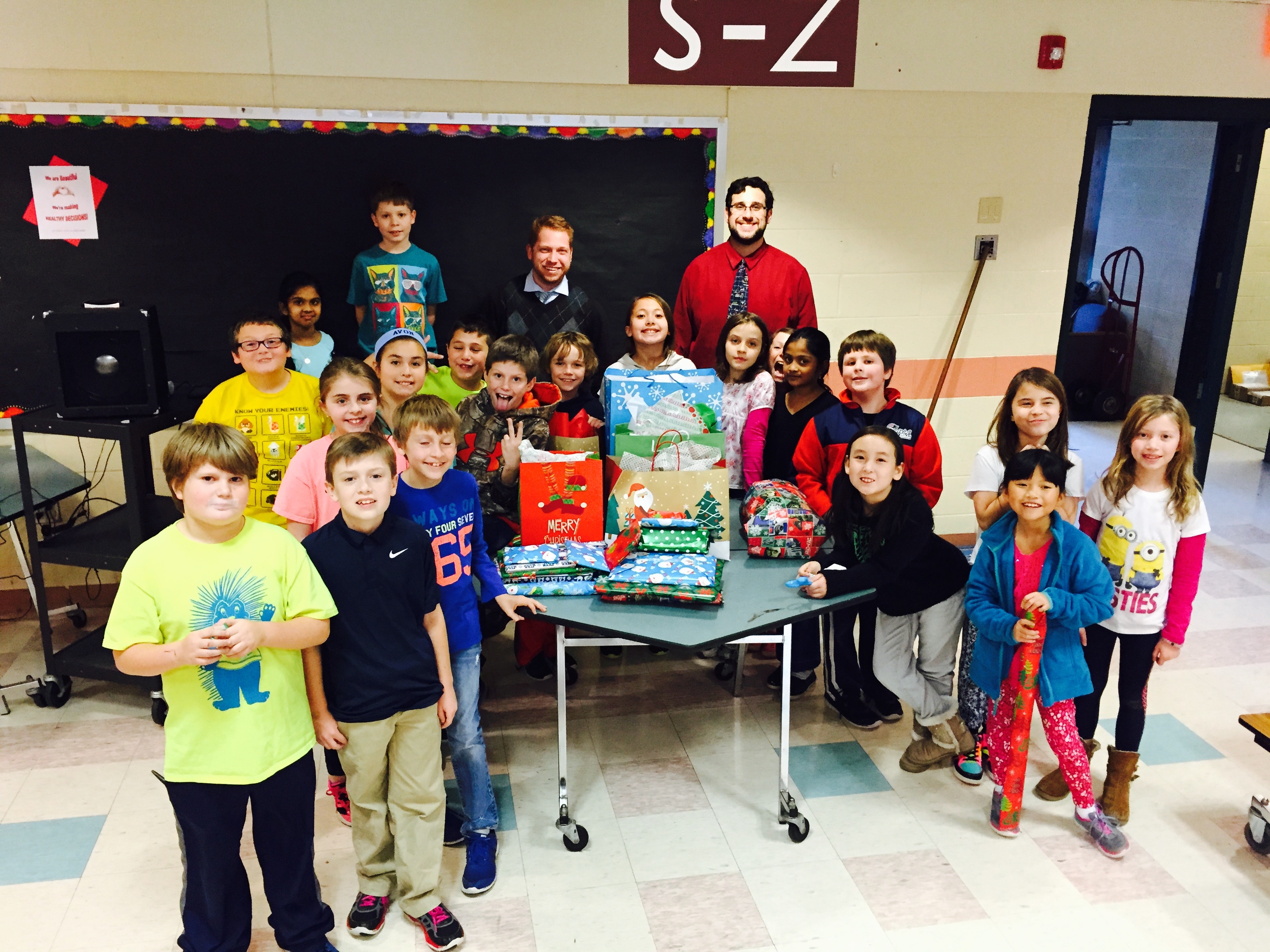Posts By: Jon Moss
January 25, 2016
Cub Reporter Message: Learning About Fractions
Written by Student #20
Hi parents, teachers and whoever else might be reading this. This is #20 here. I have an impulse to tell you something very important that we have been working on…EATING CANDY! Nah i’m just kidding, though I wish eating candy WAS one of the things we were working on. The real thing we are working on is fractions. We haven’t gotten to adding, subtracting, multiplying and dividing, but have been working on generating and figuring out equivalent fractions. Actually, the more I think about it we DID eat candy. On the first day of fractions we broke up, then ate Hershey bars. On the second and third days we worked on generating equivalent fractions. On the fifth and sixth days the class “added” fractions with shape blocks, for example:
 (Editor’s note from Mr. Moss: This lesson presented a hexagon as the whole. So a trapezoid was worth 1/2, and two halves equaled a whole. A triangle was worth 1/6, because six of those blocks equaled one hexagon block.) After that we worked on recognizing equivalent fractions for two or three day. Most recently, we have been comparing fractions with benchmark numbers, for example:
(Editor’s note from Mr. Moss: This lesson presented a hexagon as the whole. So a trapezoid was worth 1/2, and two halves equaled a whole. A triangle was worth 1/6, because six of those blocks equaled one hexagon block.) After that we worked on recognizing equivalent fractions for two or three day. Most recently, we have been comparing fractions with benchmark numbers, for example:
I hope you have enjoyed (and understood) this edition of cub reporter updates.
Posted in Class Updates, Student News|By Jon Moss
January 22, 2016
Diversity and Civil Rights – Part 2

Pictured: Martin Luther King (2nd from left) and Abraham Joshua Heschel (right)
Today, we finished reading As Good As Anybody. You may remember that the first half of the book introduced us to Martin Luther King, Jr., starting from when he was a young boy. The second half of the book taught us about Abraham Joshua Heschel, a Jewish man who fought for the rights of Jews who were being persecuted, much as Dr. King did for African Americans. The two men teamed up and worked together to accomplish their shared goal of earning equal civil rights and fair treatment for ALL.
While the kids were, of course, familiar with Dr. King, Abraham Joshua Heschel was a new name to them. The book hints at how Jews were treated unjustly in Europe during World War II, and it lets us add to our previous understanding of discrimination by race or gender by understanding the idea of discrimination by religion. This transitions beautifully to an activity we’re starting next week.
Posted in Class Updates|By Jon Moss
January 20, 2016
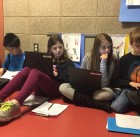
Learning to Appreciate Poetry
“Poetry is boring!” at least, according to many fourth graders. Or should I say, it WAS boring. Our class is wrapping up a unit of study about poetry, and it’s been a terrific experience! Fourth graders often dislike poetry, and I think one of the biggest reasons is that poems tend to be shorter and more artistic, which causes them to often offer fewer ways in which students can connect to them. We like texts to which we’re able to relate, and that often comes as the result of detail and elaboration, something often scarce in poems. Mrs. Dolch and I wanted to change the kids’ feelings, so our classes teamed up for this unit. Two weeks ago, we started our study of poetry by comparing it to traditional writing, called prose. Students learned about the kind of writing that makes poetry poetry, including the use of similes and metaphors, hyperbole (exaggeration), personification (giving human-like qualities to a non-living thing), rhyme, repeated language, rhythm, stanzas, and much more. We also learned that all songs, when spoken without musical notes, read like a poem. (This made a few poetry converts, I think.)
Last week, Mrs. Dolch and I merged our classes to start a poetry interpretation project based on the book Amber Was Brave, Essie Was Smart. This book tells the story of two sisters, but it does so in the form of over a dozen poems. Unlike stand-alone poems, these poems ffit together to give us more and more insight into the two girls, allowing the students to make more connections to the text. As we hoped, kids reported enjoying these poems more than others they’ve read. After we read the first five poems in the book, students split into groups to focus on one of the other terrific poems from the text. Each student focused on a particular area of the poetry interpretation, and those students met in “Expert Jigsaw Groups” where they shared their poems but focused in on their one areas. For example, several students who focused on theme met and discussed each of their poem’s theme, while other students met to discuss similes and metaphors in their poems. Following these discussions, the “Home Poem Groups” reconvened, and each expert reported out on what he or she learned about the poem while in their Expert Jigsaw Group. (Jigsaw groups are a form of instruction in which students work together to focus on one area, in order to build expertise, and then they come together with their other peers to each share their knowledge, which fits together like the pieces of a jigsaw puzzle. Credit to Mrs. Dolch who turned me on to this idea!) The Home Poem Groups discussed each expert’s ideas and have worked this week to develop a Google Slideshow about their poem. Later this week (hopefully) and next week, the groups will share out about their poems by reciting the poems and presenting their impressive slideshows. We have been so impressed by the students’ work and the depth of their thought! They did such a great job that we invited Mr. Giannini to join us last Thursday to see the kids in action, and he was proud of how well the kids shared their ideas and collaborated with one another!
Posted in Class Updates|By Jon Moss
January 20, 2016
Diversity and Civil Rights – Part 1
 Martin Luther King Day is such an important day in our country, and in our class, it kicks off our informal unit about Civil Rights. Yesterday, we read the first half of a wonderful book called As Good As Anybody. This book tells the story of Martin Luther King Jr., starting from his life as a young boy. It gave us a wonderful opportunity to talk about the concepts of discrimination, segregation, separate-but-equal (and the inherent flaw in that idea) and more. I’m always glad to see how confused kids are by this – The idea of treating someone unkindly because of their skin color was totally alien to the kids, and they couldn’t fathom how someone would do this to another person. To better illustrate this, we discuss the idea of gender-based discrimination: Are boys better at math than girls? A lot of people think so, so what happens when a male and female are applying for a job at an architectural firm? We discussed how some people might make an unfair decision, and we extended this to form a concept about racial discrimination. Helping kids to build a frame of reference better enables them to understand these ideas. This will launch us into our continuing study of diversity and civil rights. On Friday, we’ll read the second half of this book. Stay tuned for the second half of this message, coming at the end of this week!
Martin Luther King Day is such an important day in our country, and in our class, it kicks off our informal unit about Civil Rights. Yesterday, we read the first half of a wonderful book called As Good As Anybody. This book tells the story of Martin Luther King Jr., starting from his life as a young boy. It gave us a wonderful opportunity to talk about the concepts of discrimination, segregation, separate-but-equal (and the inherent flaw in that idea) and more. I’m always glad to see how confused kids are by this – The idea of treating someone unkindly because of their skin color was totally alien to the kids, and they couldn’t fathom how someone would do this to another person. To better illustrate this, we discuss the idea of gender-based discrimination: Are boys better at math than girls? A lot of people think so, so what happens when a male and female are applying for a job at an architectural firm? We discussed how some people might make an unfair decision, and we extended this to form a concept about racial discrimination. Helping kids to build a frame of reference better enables them to understand these ideas. This will launch us into our continuing study of diversity and civil rights. On Friday, we’ll read the second half of this book. Stay tuned for the second half of this message, coming at the end of this week!
Posted in Class Updates|By Jon Moss
January 14, 2016
Cub Reporter Message: What’s Happening in Unified Arts?
Written by Student #20
Hi! Here in Mr. Moss’s class we have many jobs such as line leader and station manager. We have started performing one called cub reporter. I am writing this because I am the first one doing it. Cub reporter is a jobs where we update Mr. Moss’s website as things happen in class. Enough with the introductions. In unified arts we have done many different things. In music we have been working on compositions that we will present with our choice of method: instrument, or vocally. As a grade, we have been working on songs for our winter concert. Miss Torres has taught us a collection of excellent songs. In Spanish, we have been working on food, or comida. The word for chicken is pollo! (pronounced poh-yo) We have also been earning letters in Spanish. They are ways of reward. If we make a word with our letters we get a celebration. In art we worked on “op”, or optical art. We used calligraphy pens to make thick and thin lines. Optical art is when the artist tricks the viewer’s eyes into seeing something. In library, aside from checking out books, we have worked on evaluating websites. We would go onto assigned websites and watch out for things that would make the website more or less credible. You can ask your child for an expanded explanation.
Posted in Class Updates, Student News|By Jon Moss
December 3, 2015
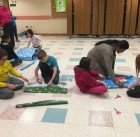
Holiday Gifts
Our class was happy to participate in a giving project in which we sponsored holiday gifts for a Connecticut student whose family would otherwise have a hard time providing gifts. This was done in conjunction with the Holiday Bear program, made possible by the Connecticut Education Association. Our class families generously sent in gifts for him, and we had a fun wrapping party where our students had a lot of fun packaging up the gifts! Thank you to all the parents who sent in gifts or wrapping supplies, and to the parents who came in to help!
Posted in Class Updates|By Jon Moss
November 17, 2015
Circus Week and Character
 We’re midway though a terrific week in room 209! On Monday, we got to watch an AMAZING performance by the National Circus Project. (I live-tweeted photos and videos from the circus.) What was particularly incredible was that the performance was an introduction for the fourth graders. Since that performance your fourth grader has been working to master some amazing skills that they first saw performed in Monday’s show. I’ve had the opportunity to see a few of the different performances, and I’m really impressed by how quickly and thoroughly the kids are mastering these skills! On Friday afternoon, fourth graders will perform for the whole school, and I hope you’re planning on coming to the kids’ evening performance on Friday night at 6:30pm. All the fourth grade teachers will be there for the fun, and I can’t wait to see the kids show all they’ve learned.
We’re midway though a terrific week in room 209! On Monday, we got to watch an AMAZING performance by the National Circus Project. (I live-tweeted photos and videos from the circus.) What was particularly incredible was that the performance was an introduction for the fourth graders. Since that performance your fourth grader has been working to master some amazing skills that they first saw performed in Monday’s show. I’ve had the opportunity to see a few of the different performances, and I’m really impressed by how quickly and thoroughly the kids are mastering these skills! On Friday afternoon, fourth graders will perform for the whole school, and I hope you’re planning on coming to the kids’ evening performance on Friday night at 6:30pm. All the fourth grade teachers will be there for the fun, and I can’t wait to see the kids show all they’ve learned.
 Curious why we’re working on the circus in school? Well, besides the fact that it’s AWESOME (C’mon, don’t we all wish we’d had a similar opportunity when we were kids?), Circus Week has given the kids an amazing opportunity to learn teamwork, perseverance as they learn a new skill, problem solving, and so much more. These are definitely key life skills that will influence their academic success now and in the future. Additionally, our school’s character focus this month and next month is on the pillar of fairness. This is a terrific time for us to have the circus, since we’re able to discuss questions of fairness, such as who got their first choice for parts in the circus, why some roles are harder or easier than others, etc. In class, we have a set meaning of the word fairness. (Ask your child if he or she remembers it!) We say: Fair doesn’t mean that everyone gets the same thing. Fair means that everyone gets what he or she needs. It may not be the most elegant definition, but it works for us! In Circus Week, this means that some kids may have an easier or harder skill to practice, and that’s fair, because everyone got a skill that’s right for them.
Curious why we’re working on the circus in school? Well, besides the fact that it’s AWESOME (C’mon, don’t we all wish we’d had a similar opportunity when we were kids?), Circus Week has given the kids an amazing opportunity to learn teamwork, perseverance as they learn a new skill, problem solving, and so much more. These are definitely key life skills that will influence their academic success now and in the future. Additionally, our school’s character focus this month and next month is on the pillar of fairness. This is a terrific time for us to have the circus, since we’re able to discuss questions of fairness, such as who got their first choice for parts in the circus, why some roles are harder or easier than others, etc. In class, we have a set meaning of the word fairness. (Ask your child if he or she remembers it!) We say: Fair doesn’t mean that everyone gets the same thing. Fair means that everyone gets what he or she needs. It may not be the most elegant definition, but it works for us! In Circus Week, this means that some kids may have an easier or harder skill to practice, and that’s fair, because everyone got a skill that’s right for them.
Posted in Class Updates|By Jon Moss
October 14, 2015
Reviewing Math Skills
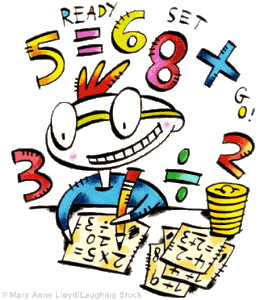 In late September, students completed the first math assessment. Normally, we strive to score these and promptly send them home for you to review, sign, and return to us. This time, however, we have intentionally held off on doing so. We found that there were several items on the assessment that were challenging to students, and we wanted to review many of these with the class. For the past few weeks, we’ve been reviewing skills with the whole class that were challenging for a large group of students. Mr. Walmer and I have also been pulling students to address skills that are best taught by repeated practice in small groups, such as rounding, multi-digit subtraction with regrouping, and standard form/word form/expanded form. As you receive and review the assessments, please rest assured that we are working with your fourth grader on any areas that he or she struggled with.
In late September, students completed the first math assessment. Normally, we strive to score these and promptly send them home for you to review, sign, and return to us. This time, however, we have intentionally held off on doing so. We found that there were several items on the assessment that were challenging to students, and we wanted to review many of these with the class. For the past few weeks, we’ve been reviewing skills with the whole class that were challenging for a large group of students. Mr. Walmer and I have also been pulling students to address skills that are best taught by repeated practice in small groups, such as rounding, multi-digit subtraction with regrouping, and standard form/word form/expanded form. As you receive and review the assessments, please rest assured that we are working with your fourth grader on any areas that he or she struggled with.
The final question on the assessment was a particularly challenging problem, in part, because it was not written in the most clear way. Many students lost points on this one question, and because it accounted for 9 points on the 36 point assessment. So you can see how struggling on this one question could dramatically impact students’ individual scores. For that reason, we strongly encourage you to look at your son or daughter’s performance on individual questions, rather than focusing on the percentage score (which, in all candor, tended to be lackluster for students throughout the class). Additionally, Mr. Walmer taught a great lesson yesterday that reviewed that challenging final question. After practicing the skill in class, students completed a similar problem, and we are so pleased that ALL students improved on their score from the assessment. Those reteaching worksheets are stapled to the end of the students’ assessments.
We ask that you take time this week to review your child’s performance on the math assessment, sign it, and PLEASE SEND IT BACK TO SCHOOL. Once again, we encourage you to examine how your child did on individual problem-sets (in rows, with the row score on the left side of the page) in order to look for strengths and weaknesses. Please don’t dwell on the percentage score, which was (for many students) pulled down by one challenging question at the end of the assessment.
Posted in Class Updates|By Jon Moss
October 4, 2015
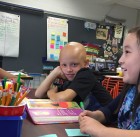
Learning to Collaborate
A big focus in Room 209 in learning to collaborate on tasks and explain your thinking. People often think that collaboration helps during challenging activities, and that’s certainly true. But we also have students collaborate even when they could easily complete a task independently, because the process of sharing ideas, considering other points of view, and discussing strategies and options helps students to think more deeply about a given topic. It also helps to develop collaboration skills that are, of course, critical life skills.
Last week, for example, we began working on narrative elements by focusing on the setting of stories. We read, as a class, The Purple Coat (one of my all-time favorites) and identified clues about the setting. I then modeled the process of writing a short-answer response (SAR) to identify and explain the setting of the story. We looked at the SAR Checklist as a way of remembering the elements of a successful short-answer response. Students then collaborated with one or two partners to write a similar response about The Josefina Story Quilt, which students read for homework on Monday or Tuesday. We shared some of these responses (from groups that volunteered) and discussed strengths and weaknesses, using the new fourth grade SAR rubric. (Stay tuned for some resources for parents!) On Friday, students worked independently to write their own SAR about the setting of A Chair for My Mother (which is arguably my all-time favorite children’s book). This process of gradual release supports students as we move from teacher-led learning to group work to independent application. You’ll see a lot of this style of learning this year, especially in the next few weeks as we address the remaining narrative elements.
Posted in Class Updates|By Jon Moss
September 25, 2015
Checking Your Child’s Spelling Assessment Results
Our first online spelling assessment went perfectly! Kids were able to complete the assessment at their own pace, and students seemed to enjoy the process of practicing their words online over the week. Because the assessments were completed online, there are not hard copies for me to send home. To check your child’s assessment results each week, have him or her log into Spelling City. On the top-right corner of the screen, click on My Records. Then, locate the spelling list for which you want to check the results, or the activity, or the date. Click on the activity name to see the results of the assessment. Please feel free to email me with any questions! Enjoy your weekend!
Posted in Class Updates|By Jon Moss


